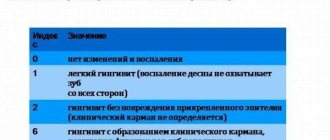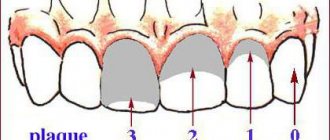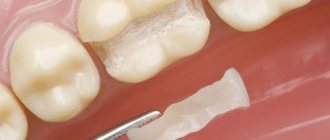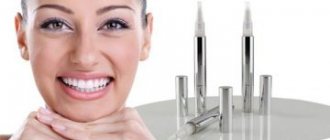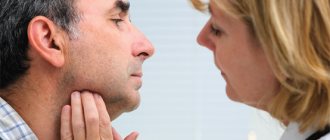The formula will help determine the condition of the mouth
To determine the condition of the oral cavity in medicine, there are about 80 different hygiene indices, based on the principle of staining the enamel with a special solution and identifying dental plaque.
According to the parameters they define, indices can be classified into 4 groups, assessing:
- area affected by plaque;
- thickness of plaque on teeth;
- mass of plaque;
- other parameters of dental plaque (chemical, physical and microbiological).
Mouth rinse
Many patients ask: “What should I rinse my mouth with?” If your gums are inflamed, you can use antimicrobial (antiseptic) and anti-inflammatory agents. Antiseptic drugs act on pathogenic bacteria that cause suppuration. Anti-inflammatory drugs have virtually no effect on viruses, but they can slow down the development of the disease.
So what should you rinse your mouth with if your gums are inflamed? Doctors recommend:
- For periodontitis or gingivitis, use both types of products, although antimicrobial ones will be more effective.
- When the socket of an extracted tooth becomes inflamed, antiseptic agents, for example, Chlorhexidine, should be used.
If you always wash your hands before eating and brush your teeth and tongue afterward, you will have a sparkling smile for many years to come.
CPU in dentistry
Dentists should use these calculations during the initial examination of the patient. So, for example, the average values of the indices KPU, kp. KPU+KP of teeth and cavities in dentistry allows you to determine the intensity of carious lesions. These abbreviations contain the following meanings:
- K – carious permanent teeth;
- P – permanent teeth in which a filling is installed;
- U – extracted molars;
- j – temporary teeth affected by caries;
- p – filled temporary teeth.
- According to the World Health Organization, the average CP index for children 12 years old should be from 2.7 to 4.4, and for citizens aged 35-44 years 6.3-12.7.
Serious shortcomings
Significant flaws in the indicators of KPUz and KPUpov include their uncertainty with increasing decay due to the formation of new depressions in healed teeth, loss of fillings, the occurrence of secondary caries and similar factors.
The multiplicity of caries is shown as a percentage. To do this, the composition of people in whom this disease was found (except for focal demineralization) is divided by the number of those studied in this team and multiplied by one hundred.
In order to assess the prevalence of tooth decay in a particular region, the following estimated conditions for the level of prevalence among twelve-year-old children are used:
- low intensity level – 0-30%;
- relative – 31-80%
- large – 81-100%.
Simplified index (IGR-U)
The Green Vermillion Hygiene Index measures plaque and tartar on the surfaces of the 2 upper first molars, 2 lower first molars and 2 upper incisors.
Ratings are given as follows:
- 0 – no plaque;
- 1 – no more than 1/3 of the tooth surface is covered with plaque;
- 2 – plaque affects from 1/3 to 2/3 of the tooth;
- 3 – dental plaque covers more than 2/3 of the surface.
The simplified hygienic index is calculated by adding the plaque index and tartar index on 6 teeth.
Cliche
The calculation formula is attached as follows:
IGR-u = sum of plaque values/number of planes + sum of stone values/number of surfaces.
The interpretation of the index (the IGR value at the level of medicine) is proposed as follows:
- 0.0-1.2 - flawless;
- 1.3-3.0 – acceptable;
- 3.1-6.0 – low.
The Green-Vermilion index has the following values for dental plaque standards:
- 0.0-0.6 – impeccable;
- 0.7-1.8 – tolerable;
- 1.9-3.0 – bad.
PMA – papillary-alveolar-marginal index
When calculating the PMA index, a solution of iodine or Lugol is used, which is applied to the gums and the degree of tissue inflammation is determined by the reaction to the irritant.
The evaluation criteria are:
- 1 – if the papilla (P) is inflamed;
- 2 – in case of inflammation of the marginal edge (M);
- 3 – inflammation of the alveolar part of the gum (A).
Formula RMA = Sum of points/n*3 (in percentage), where n is the number of teeth (up to 6 years – 20 teeth; 6–12 years – 24 teeth; 12-14 years – 28 teeth; over 15 years – 30 teeth) .
If the value is less than 30%, then the degree of damage is mild, 31-60% is moderate, 61% or more is severe.
1
Indexes in dentistry. Periodontal index, RMA, KPI, oral hygiene index
1. The prevalence of caries is an indicator determined by the ratio (the number of people with caries/the total number of those examined) * 100%
Criteria for evaluation:
- 0 – 30% low prevalence of caries
- 31 – 80% average prevalence of caries
- 81 – 100% high prevalence of caries
2. Intensity of caries - characterized by the degree of damage to teeth by caries and is determined by the average value of the CP indices of teeth, cavities (CP) and surfaces. For permanent teeth index KPU of teeth, cavities (KPUp) and surfaces (KPUp)
K - caries, P - filling, U - removed. Sum k + n + y
| 12 years | 34-40 years old |
| 0 to 1.1 very low intensity 1.2 – 2.6 low 2.7 – 4.4 average 4.5 – 6.5 high more than 6.6 very high | 0 – 1.5 very low intensity 1.6 – 6.2 low 6.3 – 12.7 average 12.8 – 16.2 high more than 16.3 very high |
WHO proposes the following levels for assessing the intensity of dental caries using the index KPU or KP.
3. Index for assessing the condition of the periodontium KPI (complex periodontal index) - allows you to determine the prevalence and intensity of signs of periodontal damage (bleeding gums, the presence of pathological pockets, the presence of dental plaque, tooth mobility).
Assessment of the condition of periodontal tissues is carried out using button probes in the area of 6 or 10 index teeth.
- 0 points – in the case when there is no plaque, bleeding, etc.
- 1 point – plaque is detected in the area of the tooth
- 2 points – bleeding appears
- 3 points – presence of tartar
- 4 points – presence of a pathological pocket
- 5 points – tooth mobility
Age:
- At 3-4 years, four fifths of the teeth and the upper right and lower left incisors are examined. (55, 51, 65, 76, 71, 85)
- 7 – 14 years (16,11,26,36,31,46)
- 15 or more years (17,16,11,26,27,37,36,31,46,47)
Calculation formula: KPI (sum of points)/(number of teeth (6 – 10).
If one tooth has several signs, the larger sign is taken.
Criteria:
- 0.1 – 1 risk of disease
- 1.1 – 2.0 – mild degree of damage
- 2.1 – 3.5 average degree of damage
- 3.6 – 5.0 severe degree of damage
Calculation of the prevalence of signs of periodontal disease in each group of subjects is determined by the number of individuals for whom this sign was the worst. Divided by the number of people examined and * 100%
4. PMA – papillary-alveolar-marginal index.
Calculation of the PMA index based on the Schiller-Pisarev test allows you to quantify the degree of gum inflammation.
Criteria:
- Inflammation of the papilla (P) – 1 point
- Inflammation of the marginal edge (M) – 2 points
- Inflammation of the alveolar part of the gums (A) – 3 points
РМА = Sum of points/n*3 (in percentage), where n is the number of teeth (up to 6 years – 20 teeth; 6–12 years – 24 teeth; 12-14 years – 28 teeth; over 15 years – 30 teeth).
RMA Index Score:
- Up to 30% – mild degree of damage
- 31 – 60% – average degree of damage
- 61% or more – severe degree of damage
Before the study, it is recommended to use 3% - 5% iodine tincture, Lugol's solution or Schiller-Pisarev dye.
5. Periodontal index (PI)
It indicates the severity of destructive processes in the periodontium and is one of the irreversible indicators.
Criteria:
- 0 – no changes
- 1 – gingivitis, mild inflammation of the gums does not spread around the tooth, there are no changes on the x-ray
- 2 – gingivitis, there is no visible lesion of the marginal attachment, no changes on the radiograph
- 6 – gingivitis, presence of a periodontal pocket, no tooth mobility and dysfunction; X-ray shows loss of bone tissue of interdental septa by ½ length
- 8 – severe destruction of all periodontal tissues with loss of function, tooth mobility; X-ray shows bone loss of more than ½ length
Calculation: PI = sum of codes of each tooth/number of teeth
6. CPITN (index of need for the treatment of periodontal diseases)
It is necessary to examine the surrounding tissues in the area of 10 teeth: 17, 16, 11, 26, 27; 37, 36, 31, 46, 47.
The results of the examination of this group of teeth allow us to obtain a complete picture of the condition of the periodontal tissues of both jaws.
Grade:
- 0 – no signs of disease
- 1 – gum bleeding after probing
- 2 – presence of supra- and subgingival tartar
- 3 – pathological pocket with a depth of 4 – 5 mm
- 4 – pathological pocket with a depth of 6 mm or more
7. Prevalence of non-carious enamel lesions ; during examination, enamel hypoplasia and fluorosis are recorded. The vestibular surfaces of teeth 11,12,13,14,21,22,23;24,3646 are examined. The presence on them of manifestations of limited or diffuse spotting of hypoplasia or their combinations, expressed in %, is recorded.
8. Level of dental care: USP = 100% – (100* (K+A)/ (KPU))
KPU – average intensity of dental caries in the study group
K – average number of carious teeth and fillings with recurrent caries.
A – average number of extracted teeth not restored with a prosthesis.
Index interpretation:
- 0–9% poor level of dental care
- 10 – 49% insufficient level of dental care
- 50 – 74% satisfactory level of dental care
- 75% or more good level of dental care
9. Oral hygiene index according to Fedorov – Volodkina:
We use solutions of iodine or potassium iodide (iodine crystal 1 g, potassium iodide 2 g, distilled water 40 ml). for lubricating the vestibular surface of 6 frontal teeth LF.
Grade:
- Coloring the entire surface of the crown – 5 points
- Staining ¾ of the crown surface – 4 points
- Staining ½ of the crown surface – 3 points
- Staining ¼ of the crown surface – 2 points
- No staining – 1 point
10. Podshadlei and Haley (1968) proposed oral hygiene performance index After applying dyes and rinsing the mouth with water, a visual inspection of 6 teeth is carried out: buccal surfaces 16 and 26, labial surfaces 11 and 31, lingual surfaces 36 and 46.
The surface of the teeth is conventionally divided into 5 sections: 1 – medial, 2 – distal, 3 – mid-occlusal, 4 – central, 5 – mid-cervical. Codes are determined at each site: 0 – no staining; 1 – painting any surface. The calculation is made using the formula: IG = ZN/n, where ZN is the sum of codes for all teeth; n – number of teeth examined; an indicator of zero indicates excellent, and 1.7 or more indicates unsatisfactory hygienic condition of the oral cavity.
11. Simplified oral hygiene index (Green, Vermillion, 1964) - determination of plaque and tartar on the buccal surface of the first upper molars, the lingual surface of the first lower molars and the labial surface of the upper incisors: 16, 11, 21, 26, 36, 46 In this case, scores are used: 0 - absence of dental plaque, 1 - dental plaque covers no more than 1/3 of the tooth surface, 2 - dental plaque covers from 1/3 to 2/3 of the tooth surface, 3 - dental plaque covers more than 2 /3 tooth surface.
The dental plaque index (DPI) is calculated using the formula: DPI = sum of indicators 6 teeth/6.
Tartar index (TQI)
- 0 – no stone
- 1 – supragingival stone on 1/3 of the tooth surface
- 2 – supragingival stone on 2/3 of the surface of the crown or in separate areas
- 3 – supragingival calculus covers more than 2/3 of the tooth surface, subgingival calculus surrounds the neck of the tooth.
IZK = sum of indicators 6 teeth/6
UIG = IZN + IZK
12. Increase in caries
– the number of new carious lesions over a certain period.
To do this, determine the intensity of caries in the same person or contingent after 3 to 5 years. It is believed that a period of 1–2 years may not be sufficient for this.
Php Index
Scientists Podszadlej and Haley developed an oral hygiene performance index. First, a dye solution is applied to the teeth, then the patient rinses his mouth with water, and 6 teeth are examined. In this case, their surface is divided into 5 sections: medial, distal, mid-occlusal, central, mid-cervical. The absence of staining is determined by zero, and the presence - by one.
When calculating, use the formula: IG = ZN/n, where ZN is the sum of codes for all teeth; n – number of teeth examined. With a value of 0, the condition of the oral cavity is considered excellent, and with a value of 1.7 or more, it is considered unsatisfactory.
Norm
The Fedorov-Volodkina index (1968) is still used in our country today.
First, the labial surface of the six front lower teeth is stained with a potassium-iodine-iodide solution. The hygienic index is determined by the intensity of the resulting color, then it is assessed using the five-point method and calculated using the formula Kcp=(∑Ku)/n, where:
- Ksr – general hygienic cleaning coefficient;
- Ku – healthy indicator of cleaning one tooth;
- n – number of teeth.
Coloring the entire plane of the crown means 5 points; 3/4 – 4; 1/2 – 3; 1/4 – 2 points; lack of color – 1. Normally, a healthy indicator should not exceed 1.
CPITN (periodontal disease treatment need index)
This method covers 10 teeth, allowing the dentist to see the condition of the gums of the upper and lower jaws. Grades are given as follows:
- 0 – no disease symptoms;
- 1 – gums are bleeding;
- 2 – tartar was found above and below the gum;
- 3 – gum pocket 4-5 mm deep;
- 4 – gum pocket more than 6 mm.
It may come as a surprise to many that the condition of teeth can be determined using a formula, but this is the truth. Therefore, do not neglect maintaining oral hygiene, so as not to be a poor student in this calculation.
The iOrtho clinic network provides high-quality services for correcting malocclusion with Invisalign aligners, sign up for a consultation now!
Observation of children
By calculating the Green-Vermilion index, doctors can create dispensary groups for monitoring children:
- Group 1 – children who have no pathologies;
- Group 2 – actually healthy babies with a history of any chronic or acute disease that does not affect the function of the most important organs;
- Group 3 – children with chronic illnesses with a balanced, sub- and decompensated course.
There are three phases in the dental examination of children:
- In the first phase of the examination, each child is individually recorded, an additional examination is carried out in the hospital, then an outpatient observation group is determined, the endurance of each child is assessed and the order of examinations is determined.
- In the second, a contingent is formed according to supervision groups, uniform conditions for phasing and continuity of study are assigned, dispensary patients are proportionally divided between doctors, and the needs of the examined contingents in inpatient and outpatient treatment are met.
- In the third, doctors determine the frequency and nature of active supervision of each child, adjust diagnostic and treatment measures in accordance with changes in health status, and evaluate the effectiveness of supervision.
Of great importance is the organization of educational work to prevent dental diseases in children and create motivation to care for newly emerging teeth.
General overview
In dentistry, indices are a quantitative reflection of the progress of the pathological process that has developed in the periodontium.
When compared with clinical diagnostic methods, index assessment is considered relative, since it does not reflect the absolute accuracy of the ongoing process.
But periodontal indexing has some advantages that distinguish it from clinical diagnosis. With its help you can:
- measure the dynamics of tissue infection;
- monitor the spread and development of periodontal diseases;
- monitor the progress of treatment;
- evaluate its success and the results of preventive measures;
- perform epidemiological screening of the population;
- make comparisons of the results of different studies.
There are several dozen assessment indices for studying the condition of periodontium. All of them are divided into 3 groups:
- Reversible . With their help, the dynamics of diseases and the effectiveness of treatment are assessed. Reflect the severity of the inflammatory process, bleeding gums, loose teeth, the size of periodontal and gum pockets.
- Irreversible. They convey the manifestation of such signs as resorption (absorption) of bone tissue in the alveolar process, amyotrophy of the gums.
- Complex. They help to give a comprehensive description of the condition of periodontal tissues, taking into account the existing symptoms and the degree of development of pathological processes.
